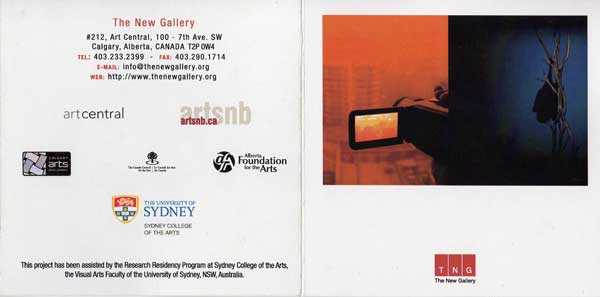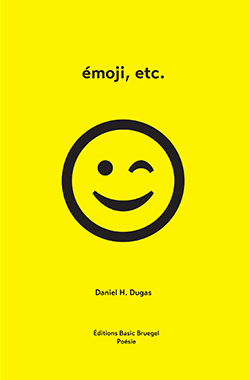Street / Screen Encounter (2012)
Write up of the MediaPackBoard experience / involvement with the World Portable Gallery Convention, Halifax, NS. Enjoy!
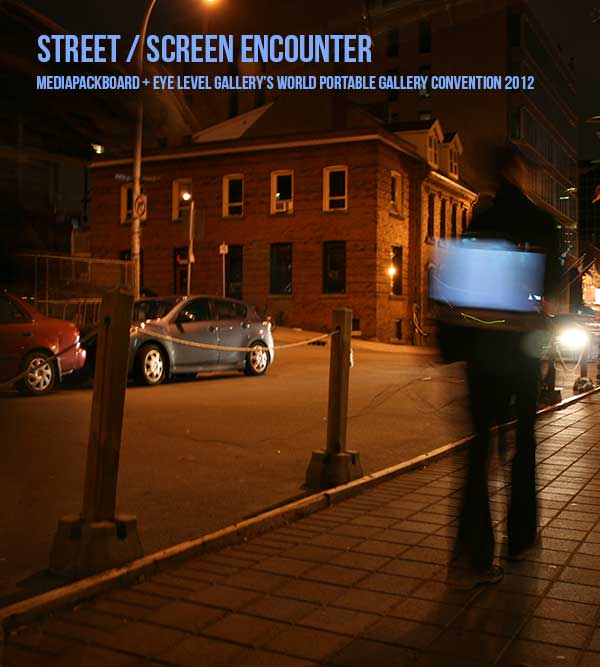
MPB at the WPGC (2012)
World Portable Galleries Convention 2012
Halifax, NS
A collaborative work instigated by Daniel Dugas and Valerie LeBlanc
Here is a first glimpse at the project. We will be adding to the documentation.
For the WPGC we assembled a bamboo ‘fishing pole’ and hooked up a mini-spy cam to it. Valerie put on the MPB and we stepped out to explore views of the city not readily visible to passersby. We talked with other pedestrians and pointed the camera into spaces that they were interested in examining. Several of the WPGC curators and Eye Level Members stepped out with us to try out the apparatus. As images were transferred from the spycam to the MPB monitor, we used a separate camcorder to record what the spycam saw.
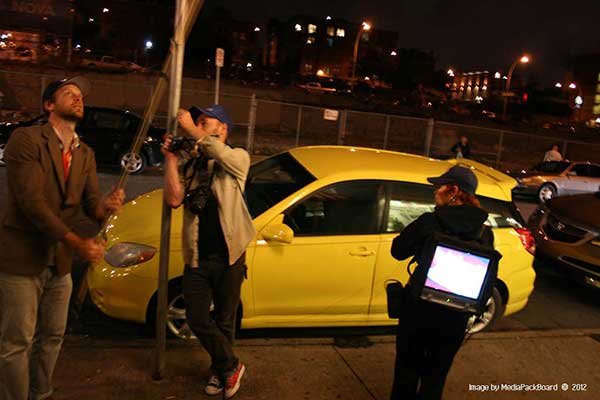
With Michael McCormack (fishing pole) and Matthew Carswell (camera)
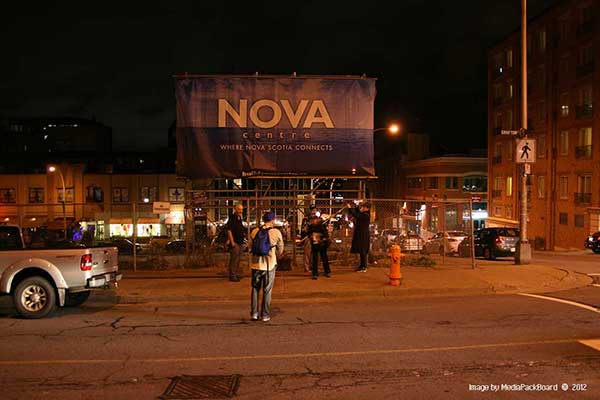
Michael Eddy (fishing pole) looking at the sign

Valerie LeBlanc carrying the MPB on Argyle St.

Michael Eddy lifting the fishing pole
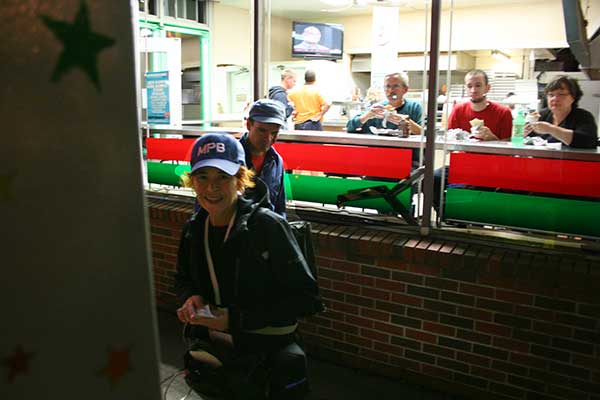
In front of the Tony’s Pizza on Robie St., diners onlooking
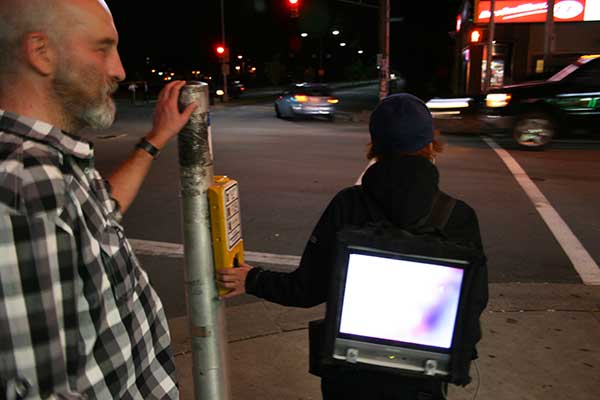
Andrew McLaren on corner of Cunard and Robie, September 7 during the opening at the 161 Gallon Gallery
This project has been made possible with the support of artsnb

and EyeLevel Gallery and its funders
![]()
WPGC 2012 schedule (2012)

The World Portable Gallery Convention 2012 is an international convention on portable galleries and alternative spaces hosted by Eyelevel Gallery during the month of September. The project celebrates the variety of spaces with which curators around the globe have extended public interaction with art institutions.
Thursday, September 6th
CALL: Eyelevel Gallery at (902) 425 6412
World Portable Gallery Convention (2012)
Valerie LeBlanc and I are bringing the MediaPackBoard to EyeLevel Gallery in Halifax to participate in the WPGC 2012! It’s going to be great ! More to come later, in the meantime, here is the poster.

Soundbury – Commentaire par Thierry Bissonnette
Soundbury
Thierry Bissonnette

Soundbury
Thierry Bissonnette
Français
Daniel Dugas et Valérie LeBlanc se sont faits chasseurs cueilleurs sonores lors de la foire d’art sudburoise. Ces artistes de Moncton ont déambulé parmi les activités de la FAAS 2010 afin de prélever des séquences qui formeraient Soundbury, une collection en ligne de moments audio qui livre leur vision singulière d’une période effervescente sous la forme d’une «cartographie sonore de Sudbury».
Durant douze heures, Dugas et LeBlanc ont promené leurs micros pour capter des moments témoins de leur dialogue silencieux avec une ville et des artistes qui l’animaient. Ces moments sont fortuits, discrets, hétéroclites : un ruban adhésif qui flotte au vent, un tenancier qui réfléchit sur le retour tardif de la neige, un commentaire sur des bonhommes de neige intempestifs, un homme qui fait rouler son chariot sur le pavé de la rue Elgin, un poème énoncé dans une chambre d’hôtel, l’attente près des portes de la galerie d’art, l’essai de guitares dans une boutique… Affichées progressivement sur le site Web et représentées par une photo et une rubrique, ces séquences sonores naviguent entre l’art et le non-art apparents.
L’imaginaire de l’objet, du sujet et du récepteur sont inhérents à ces fragments sonores. Car si Soundbury a fouillé la ville pour y trouver des bouts d’âme, sa structure n’est complétée que par l’auditeur qui s’engage à composer un parcours. Ce faisant, on crée et on explore une ville miniature qui n’existe que dans l’ouïe, le temps d’une visite en diagonale.
English
Arriving from Moncton, Daniel Dugas and Valerie LeBlanc became hunter-gatherers of sounds during Sudbury’s alternative arts festival. Drawing from their rich background in online projects and exhibitions – he is a poet, she is a professor, and both are videographers – they meandered through the activities of the FAAS 2010 to capture audio clips that would eventually provide raw material for Soundbury, a collection of moments in sound expressing their particular vision of an effervescent time.
Soundbury can now be heard in its entirety on the site http://soundbury.wordpress.com. Its creators describe it as “a sonic cartography project, an audible image of the city of Sudbury” Over a twelve hour period, Dugas and Leblanc pointed their microphones at key moments that witnessed their silent dialogue with a city that was teeming with artists and writers, but also with the city’s more discrete aspects. This affinity for dialogue is also evident in the title of Daniel Dugas’ book of poetry, Hé!, which had recently been published by Prise de parole. Chance encounters often produce this familiar and fabulous exclamation.
As they brought back a number of short-lived moments, the two artists constructed a mish-mashed intersection that nonetheless bears their signature at its vanishing point. Thirty rubrics, each one introducing one or two sequences, were gradually uploaded onto the site. Today, they can be heard in the reverse order or in a non-numerical order. A visiting ear can wander as it pleases, starting with the final clip where trains pass by in the night, moving on to a moment captured at Peddler’s Pub on Cedar Street, or pausing by a ventilation outlet behind Durham Street, before opening a small window on the performances of Tania Lukin or Thierry Marceau. A strip of adhesive tape flutters in the wind; a tenant reflects on the unseasonal snowfall; someone comments on untimely snowmen; a man pushes a buggy over pavement on Elgin Street; a poem is read in a hotel room; patrons wait outside the art gallery; guitars are strummed in a music store… all these clips, each one represented by a still photo, plot a course between art and apparent non-art. Should a listener be so inclined, more than one clip can be heard simultaneously.
As we sift through this collection, we realize ever more clearly how these brief fragments combine the imagery of their objects, subjects and receivers. Soundbury tunneled into a city to find flecks of its soul, but its structure is not complete until the listener has recomposed its trajectory and created a miniature city that exists only in the vibrations of eardrums and in the moments of a visit in passing.
For a general overview of the experience, visit http://soundbury.wordpress.com/google-map/, where a map indicates all the places where audio samples were obtained. A click on a mark displays the corresponding title and still image, and the audio sequence can be played. The result is an unusual map that can be used to discover downtown Sudbury, thanks to two generous artists from New Brunswick.
Hors Lieux
Une Rétrospective de la foire d’art alternatif de Sudbury 2010,
Français : p 23
English: p 61-62
La Galerie du Nouvel-Ontario
ISBN 978-2-923024-51-6
Cafe Poet Program (2012)
Good news from Australia and the USA! I have been selected for the Cafe Poet Program from the Australian Poetry for a six months residency at the Marrickville Road Cafe in Sydney. My residency starts on July 1st 2012. I have also been invited by JUiCYHEADS, a New York-based ezine/website, to be one of their poetry columnists. I will be contributing texts to JUiCYHEADS from my Australian project every two weeks for the duration of the residency.
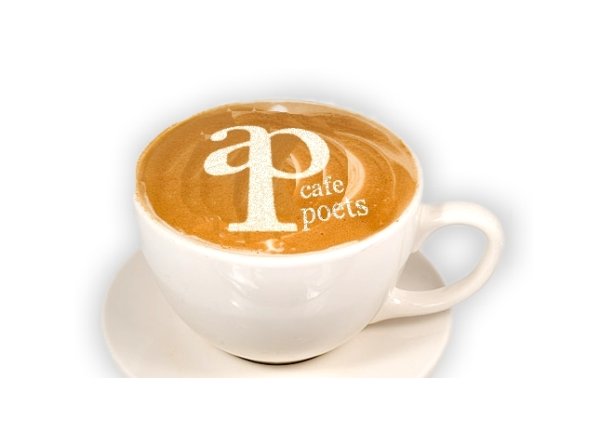
Here is a description of the Cafe Poet Program:
The Cafe Poet Program places poets in cafes as ‘poets in residence’ for a six month period. The poet is given space to write (maybe two or three times a week – in consultation with the cafe) as well as complimentary tea and/or coffee and in return the cafe gets to be part of this community, promotion and the opportunity to plan events with the poet enriching the cultural life of the cafe (and hopefully the number of patrons). The program began at AP in February 2009 and has been a huge success, placing more than twenty poets in cafes all over the country and receiving extensive media coverage. We have also connected cafe poets with various opportunities including working with RMIT media students and being published in the 2009 edition of Blue Dog: Australian Poetry.
Check out the Cafe Poet facebook page
Marrickville Road Cafe


Agrandir le plan
Artist Talks (2012)
The following are transcripts of the talks Valerie LeBlanc and I gave at The New Gallery on January 5th 2012 during the opening of our video installation What We Take With Us.
VALERIE LEBLANC
Thank you to: everyone at the New Gallery who worked to bring us here and to Tim and Jessica for smoothing out crimps during the actual installation of WHAT WE TAKE WITH US. Special thanks to Tomas Jonsson, Kathryn Blair and John Snow House Director, Shara Rosko.
For any artist, starting a new year, exhibiting an artwork is the best possible scenario. The chance to visit Calgary is amazing. It puts me on the spot, to not only say what I have been doing, but also to evaluate what I have done since leaving the city in 2008.
The chance to show this work in Calgary seems so appropriate as Daniel and I continue to think of Calgary as our second home. But more than that, the initial planning for the installation began in Calgary, early in 2007 while applying to the University of Sydney to carry out the residency. Another version of the installation was shown – for one day only, in January 2011 at the Galerie E Dans L’A, in Moncton, New Brunswick where we currently live. So presenting at The New Gallery completes a cycle of intentions embodied in this work.
Sometimes it seems as if living is about managing points – not the points that have synched with all monetary transactions – but those emergency points that drive us from event to event. WHAT WE TAKE WITH US wants to step back from the edge to place value.
When I first entered the art world, deconstruction was big. Anecdotes were frowned upon. In the classroom and gallery, if storytelling was an employed methodology, it was required to appear only in the most pure, most elemental of symbols. And yet the idea that everything moves in circles – and that there is nothing new under the sun was also brought forward. We are fortunate to live and work in a time period when visual and audio collage, in all of its forms has place – and that the specific arrangement of elements, with emphasis on time and space are valued. Since access to digital tools became both available and affordable to artists and consumers, it facilitated possibilities for creation, communication and for description. As we are well aware, these same tools are utilized in the constant bombardment of marketing. That presents a complication of finding meaning in creation that dwells within or moves beyond product placement. In the immersive environment, we are challenged to captivate imagination, or to lay out elements that offer / share inner experience.
This project was based upon travel, personal exploration of specific geographies but also upon meeting people, chance conversations, and interviews. In the making of the videos and the creation of a format, it was important for each of us to move past the first level of the experience, to allow events to distil over time through memory and impact. Through the process of building something in time based art; having a cut and paste-able timeline similar to our own ideas of memory and its very complicated architecture, is modern magic. If memory is a string of events (pearls) stretched out over time, then creating videos or any artwork can be a way of re-stringing the whole poetry of it.
It would seem that an artwork should always exist between reality and dream / influences and changes that become absorbed. The video loops projected onto the walls of the gallery, and the soundtracks carried by the corresponding left or right headphones work to create an immersive environment for contemplation. Those soundtracks, texts and visuals are meant to flow and to interact as the projections loop. The ‘open sound’ heard upon entering the space creates another element closer to actual experience of travel and interaction with others. One of the topics that came up in the interviews is reconciling the feelings of attachment you feel for a place when you are now there, and how it reverses when you go back and leave the second home.
To speak more generally of my practice, basically, I do 2 things: I create from within, working through thought process and visceral reality; and I ask (interview) others about what they do. In that, the best that I hope for is to bring out other voices, and to create a dialogue. 2011 was a busy and productive year – something I always strive for, unusual in the mix, was the gift of reaction to some projects. In particular, I presented videos in 3 European capitals: DOWNUNDER was curated into the She Devil Exhibition at the MACRO – Museum of Contemporary Art, Rome, Italy. The She Devil screenings ran from June 25, 2011 – January 8, 2012 in the MACRO’s V-Tunnel. On November 4 & 5, I presented The Renovation, at the Ruins in 20th Century Art and Literature Conference at the Senate House in London, England. My 2011 video Paper Moon, Cardboard Sky [1], was screened at the 24th Instants Video at the gallery Le 104, Paris, France.
Those 3 presentations rose were facilitated through Internet connections. What we have seen demonstrated so well with the Internet is that individuals and communities are no longer only linked to geography or birthright, or even common history. A sense of belonging can rise from topical common interests and affinities. The reasons for some of those connections might appear obvious by magnitude, and some, although seemingly banal, might ‘hold more water’ than detected in the real time of the moment.
As important as visual and sound cues are into positing the space of habitation, writing has become very important for me. Sometimes, it is in a manner of connecting events and thoughts in as orderly a form as an essay. And sometimes it is in arranging those same events and thoughts into poetry using visuals, sound and texts. What We Take With Us takes that form; aiming to float and ground in the memory of connections over time.
Audience / participants should be and are – everywhere. Everyone has a voice and wants to be heard. Maybe taking part in what happens in an art gallery creates a necessary pause; that kind of pause that can help us step outside of the daily rush and routine. A new starting point can arrive unexpectedly. Recognizing it can become a refreshing experience, like celebrating the beginning of a new year.
In 2012 Valerie LeBlanc will be starting a PhD in the Visual Arts at the University of Sydney in Australia.
[1] Also screened in 2011 as part of OIL, EMMEDIA, Calgary, AB July 12, and at the OK.Quoi?!,Contemporary Arts Festival, Sackville, NB July 28.
DANIEL DUGAS
A HISTORY MORE SATURATED
IMAGE & FIRE
We have all seen this: a house on fire, an apartment burning, in the middle of the night. It could have been a short in the attic, a cigarette in a bed, a curtain too close to a space heater. The firefighters are there. It’s cold; the residents are outside looking at their houses, their rooms burning to the ground. As usual there are journalists reporting on the drama, asking questions, trying to figure out what happened. Some people step forward and brave the spot light. They have blankets on their shoulders; they look exhausted, fragile as they speak to the rapidity of the fire, the thickness of the smoke. As the camera pans onto the charred remains, it becomes obvious to everyone watching that some tenants were lucky to get out in time. But at the end of the interviews, many of the residents come to the sad conclusion that the photo albums; the memories of a lifetime, did not make it. There is a pause; most break down at the thought of the disappearing images.
In our visual society or ‘optical civilization’ as Paul Virilio likes to call it, the photo albums, analogue and digital, have transcended their mnemonic status, they have become life itself. They are what we can and cannot remember.
IMAGE & INVENTION
In 1979, at 18 years old, I hitchhiked across Canada and the USA. I decided not to bring a camera because I thought that taking pictures might interfere with my ability to remember events. In New Mexico I got a ride with an ex Korean War veteran who was also an ex Hells’ Angel. As we crossed the border between New Mexico and Texas I made the mistake of commenting on the beauty of the sky and the sunset. He said that I should take a photograph. I told him that I did not have a camera and he became quite agitated. When we arrived in Amarillo, in the panhandle of Texas, we stopped for a beer. As I sat at the counter, my driver excused himself to go to the restroom. I drank my beer, waited a while. Eventually I realized that he was gone with my backpack. At that moment, his flash of anger became clear to me. He was planning to steal my stuff and the loot was definitely lessened by the absence of a camera. Obviously I survived and made my way home from what was a real interesting trip. But the absence of physical images, of snapshots, of this wonderful sunset for example, has made room for another kind of narrative; one weaved with invention. A history more saturated if you will.
IMAGE, WORD & MEMORY
I am a videographer and a poet and I am both at the same time. I don’t see a separation between the two activities. One informs the other in a Ping-Pong way. When I was ten, I found a flat stone and I started what was perhaps my first art project. I drew symbols, scribbled on it; some were like drawings, others like letters. I buried the stone in the woods near my home thinking that archeologists might find it one day. I was thrilled at the idea and could imagine a team of scientists pondering on the origin of this unknown civilization. When I think about it today, I think it’s funny, and it is. It’s funny but it is also ironic and subversive. There is a desire to question the establishment, the world, and the memory of the world as its stand in front and around everything. I recently did a video series called TABLETS [1], a tongue-in-cheek collection of videos extolling the magical properties of technology. I think that there is a connection between these videos and that buried stone somewhere in Le Bois du Juvénat in Lévis, Québec.
What We Take With Us is about points of view, about memory and memories, about what is collected, recollected, juxtaposed and ultimately imagined. It is about image and text, about the relation between text and image, about signs, about perception. It is also a project that took us on a long circle.
As Valerie mentioned, in 2009 we were invited to take part in a research residency program at the Sydney College for the Arts in Sydney, Australia. The premise of the project was an exploration of internal and external experiences characteristic to travel and displacement. We met and interviewed people, collected images and sounds. Later, it became apparent that each of us had processed the experience of seeing and being differently; with our individual filters. Faced with the same set of circumstances, we were not seeing the same thing, and not reacting the same way. When we came back to Canada and began examining the material, it took six months of sifting for the idea of a two-channel video installation to take shape. We each started to build a distinct program of video-poems to be screened side by side. A funny thing happened, and we realized this only at the end of the creative process. Valerie’s program starts with a piece called SAMOA while my program begins with RED. Even though the programs are looped, these two videos function as metaphorical book ends for the whole project. RED is an account of the dust storm [2] that blew over Sydney a few days after our arrival on September 23. SAMOA, on the other end of the shelf, is a video that was inspired by the earthquake and the tsunami that rocked the Samoan Islands on September 29.[3] After the disaster, many islanders came through Australia to visit with family members. On the day of our departure, at the airport, October 22, a group of Samoans was going back home. Valerie noticed the gathering and stopped to listen to the singing. I was already past the gate and did not witness the scene.
We have worked together for 20 years, on different types of collaborative projects, while also carrying out individual practices. The degree of collaboration often changes depending on the nature of the project. Some are totally fused and others, as with What We Take With Us, are hybrids; comprised of discrete elements. One of our longest collaborative endeavors is probably a Dictionary of Definitions, we have been working on it since 1990 and it is still a work in progress. When we did our Masters Degrees at the School of the Art Institute of Chicago, we were accepted as a collaborative team. Our project was called Memory Bank and was about memory and fragmentation. We envisioned a giant mirror ball, a kaleidoscope of life made up of numerous poetic documents. It was supposed to be a large dome-like structure covered with video monitors, each of them showing a looped clip. At the time, 1991 – 1993, it was a difficult technical and financial challenge and so the project evolved differently. We worked on smaller scale two-channel and three-channel video installations instead. And when I look at this installation, What We Take With Us, I cannot but see some aspects of Memory Bank resurfacing.
But projects are like that, aren’t they; like Russian Dolls, nestled in each other, speaking to each other. On our way back from Australia, on that long flight back to North America, I started to write about being on the plane, about speed, about slowness, about turbulence, about the immensity of the Pacific Ocean, about the darkness of the night and the few dots of life sprinkled here and there, and about the reassuring smell of coffee floating in the cabin. These texts are now a book of poetry entitled Au large des objets perdus [4]. It was published in October 2011 at Les Éditions Prise de Parole.
Daniel Dugas
Calgary, January 5, 2012
In July 2012, Daniel Dugas will be starting a six-month residency in Sydney with the Café Poet Program [5] of the Australian Poetry.
[3] http://en.wikipedia.org/wiki/2009_Samoa_earthquake
[4] Loosely translated: Off the coast of lost objects
[5] http://www.australianpoetry.org/cafe-poet-program/
![]() Daniel Dugas Artist Talk Transcript The New Gallery
Daniel Dugas Artist Talk Transcript The New Gallery
![]() Valerie LeBlanc Artist Talk Transcript The New Gallery
Valerie LeBlanc Artist Talk Transcript The New Gallery
What We Take With Us – TNG (2012)

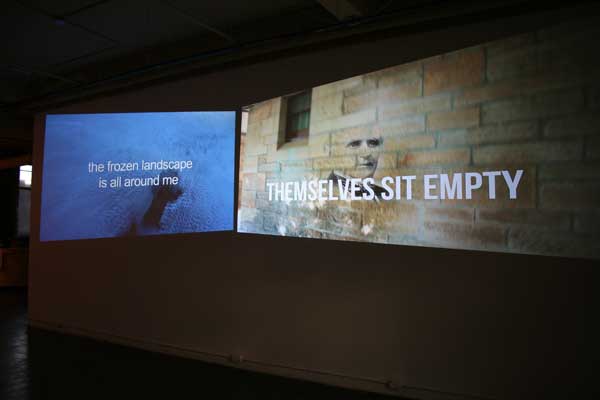
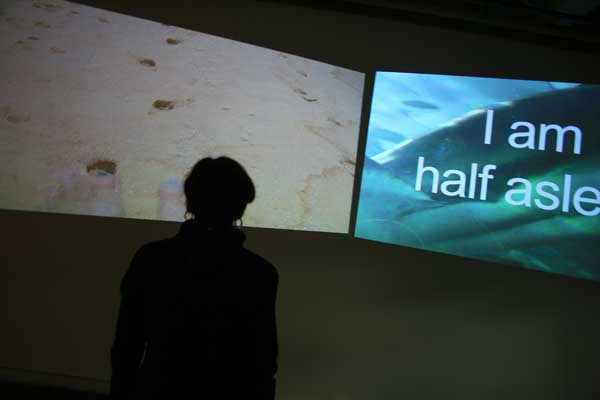
We just came back from Calgary where our video installation What We Take With Us is being presented at The New Gallery. The opening was on January 5th and the exhibition will continue until February 4th 2012. We stayed at the John Snow House which is administrated by TNG. It is an extraordinary place loaded with history.
Thanks to everyone at TNG: Tim, Jessica, Noel, Kathryn, Su, Volunteers – and all who came out to the opening! Our talks will be posted online next week.
Our installation is also part of This Is My City Festival, an interdisciplinary festival of art from the margins.
Excerpt from the essay written by Tomas Jonsson:
Recurrent waves of colonialism and globalization have smoothed and prescribed our encounters with places. For the traveler, points of difference, or of distinction, are sought after, perhaps increasingly so, or patronizingly handed over. Monuments, historical sites and natural landmarks are increasingly oriented to ‘the amused eye’, which the traveler can then compare and develop a discourse “for the comparative connoisseurship of places.”
In What We Take With Us, Dugas and LeBlanc explore a complicated, contingent terrain, whose borders extend into and circumvent geographies, both physical and social, ‘here’ and ‘away’. Encompassing individual catalysts, personal experiences, mental and body memories, the resulting landscape can’t be easily anticipated or defined.
The videos mimic the internal ordering and filtering of places. Each series of vignettes display a personal vision, reflecting the difference in interpretation even by two people so closely aligned. They follow in Dugas and LeBlanc’s collaborative approach in their production and presentation, but in this case the associations are left to chance due to an unsynched running time. The result is a constantly shifting dialogue between the videos, with unknown permutations and combinations.
Hunger / Faim (2011)
Troisième vidéo de la série Tablettes. – Third video from the Tablets series.
HUNGER
A prehistoric man stands alongside of a stream, hoping to catch a fish. Seeing that it is not going well, another caveman approaches to show the fisherman his tablet, demonstrating of a new way of eating.
FAIM
Un homme préhistorique, debout près d’un ruisseau s’adonne à la pêche, mais sans succès. Un autre homme des cavernes s’approche et lui montre une tablette où apparaît une nouvelle façon de se nourrir.
⁂
Actors/Acteurs: Jean-Denis Boudreau, Katie Hunter
Props/accessoires: Valerie LeBlanc
3. Hunger / Faim
Rock / Roc (2011)
Voici le deuxième vidéo de la série Tablettes avec Jean-Denis Boudreau et Katie Hunter.
ROC
Un homme préhistorique essaie de déplacer une grosse roche sur le flanc d’une montagne. Un autre homme des cavernes s’avance et lui montre sa tablette où les risques d’une telle activité sont mis en évidence.
ROCK
A prehistoric man is trying to move a large rock on the side of a mountain. Another caveman approaches with his tablet and brings up a safety video highlighting the risks of this activity and suggestions for safer work methods.
⁂
Actors/Acteurs: Jean-Denis Boudreau, Katie Hunter
Props/accessoires: Valerie LeBlanc
1 : Wheels / Roues
2. Rock / Roc
Daniel H. Dugas
Archives
Blogroll
- A.I.R. Vallauris
- ACAD
- Adobe additional services
- Adobe Creative Cloud
- AIRIE
- Amaas
- Amazon Author Central
- ARTothèque
- Australian Poetry
- Basic Bruegel
- Bitly
- CCCA
- CDBaby
- Cycling 74
- Dissolution
- Éditions Prise de parole
- Emmedia
- eyelevelgallery
- FAVA
- Festival acadien de poésie
- Festival FRYE Festival
- FILE – Electronic Language International Festival
- Freeware list
- Fringe Online
- Galerie Sans Nom
- Gotta Minute Film Festival
- Instants Vidéo
- JUiCYHEADS
- Kindle Direct Publishing
- Klondike Institute of Art and Culture
- La Maison de la poésie de Montréal
- La Maison de la Poésie et de la Langue française Wallonie-Bruxelles
- Laboratorio Arte-Alameda
- Le Centre Jacques Cartier
- Liberated Words
- Maison Internationale de la Poésie – Arthur Haulot
- MediaPackBoard
- Miami Book Fair International
- Monoskop
- Mot Dit
- NSCAD University
- Paved Arts
- PoetryFilm
- Portail des auteurs du Nouveau-Brunswick
- RECF
- Revue Ancrages
- Salon du Livre du Grand Sudbury
- Sculpture Space
- Subtropics.org
- Sydney college for the arts
- The Centre for Contemporary Canadian Art
- The New Gallery
- Trevigliopoesia
- tumbler-documents
- V Tape
- Valerie LeBlanc
- VideoBardo
- Void Network-Κενο Δίκτυο
Categories
- #covidpoèmes
- Advertisement
- AIRIE
- Ancrages
- anthology
- Anthropocene
- Architecture
- Around Osprey
- art
- Article de presse
- arts visuels
- audio
- Australian Poetry
- Basic Bruegel Editions
- Book
- book fair
- Cafe Poet Program
- Ce qu'on emporte avec nous
- Citations gratuites
- Collaboration
- commentaire
- commentary
- Compte rendu
- conférence
- Conservation Foundation of the Gulf Coast
- COVID-19
- Critique littéraire
- culture
- Daniel Dugas
- Design
- Édition Michel-Henri
- Éditions Perce-Neige
- Éloizes
- Emmedia
- emoji etc | émoji etc
- Environnement
- essai
- essay
- Everglades
- Exhibition
- festival
- Festival acadien de poésie
- Festival Frye Festival
- FIPTR
- Flow: Big Waters
- Fundy
- Habitat
- installation
- Instants Vidéo
- interactivity
- journal
- JUiCYHEADS
- Kisii
- L'Esprit du temps
- laptop
- Leaving São Paulo
- lecture
- Livre
- logos
- Magazine
- Miami Book Fair
- Moncton 24
- novel
- OASIS
- oil spill
- perception
- performance
- Photo
- poésie
- Poetic Licence Week
- Poetry
- politics
- politique
- press
- Prise de parole
- Revue Ancrages
- salon du livre
- sculpture
- Sculpture Space
- sound
- Souvenirs
- Spirit of the Time
- Style & Artifacts
- Symposium d'art/nature
- talk
- television
- The New Gallery
- Uncategorized
- Valerie LeBlanc
- vidéo
- vidéopoésie
- Videopoetr/Vidéopoésie
- videopoetry
- visual arts
- What We Take With Us
- youth literature









